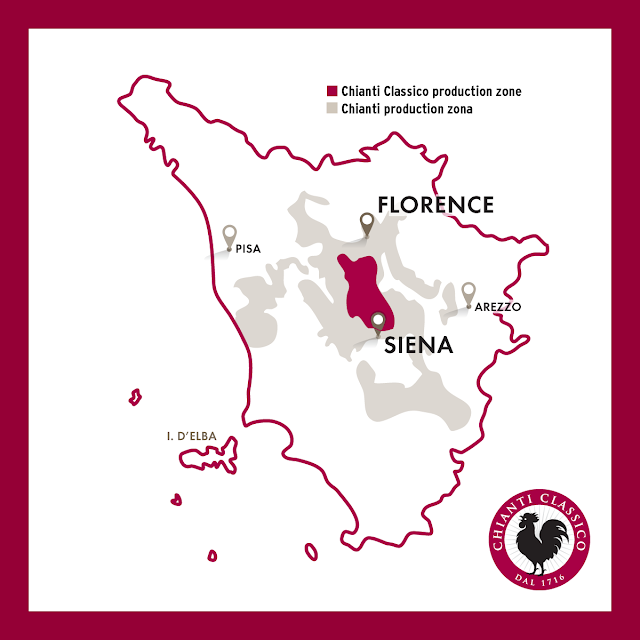A couple weeks ago I
attended a Masters class in Boston hosted by the Consorzio Vino Chianti
Classico and led by Jeff Porter. It was a horizontal tasting
discussing the diversity of Chianti Classico and its 9 communes
including:
- San Casciano in Val di Pesa
- Tavarnelle Val di Pesa
- Barberino Val d’Elsa
- Poggibonsi
- Greve in Chianti
- Castellare in Chianti
- Gaiole in Chianti
- Radda in Chianti
- Castelnuovo Berardenga
 |
| Copyright of Consorzio Vino Chianti Classico |
 |
| Gallo Nero representative of Chianti Classico |
- Castello di Gabbiano (San Casciano in Val di Pesa)
- Casa Sola (Barberino Tavarnelle)
- Cinciano (Poggibonsi)
- Il Molino di Grace (Greve in Chianti)
- Castello Vicchiomaggio (Greve in Chianti)
- Famiglia Cecchi (Castellina in Chianti)
- Fattorie Melini (Poggibonsi)
- Cantina Castelvecchi (Radda in Chianti)
- Felsina (Castelnuovo Berardenga)
- Vallepicciola (Castelnuovo Berardenga)
Although I’m sure many folks know, the wine region of Chianti Classico is located in Tuscany, which is in central Italy. It is
almost the same size as Burgundy, France and is home to about 600
producers with 7,200 hectares total (almost 18k acres). Interesting
fact is that about 40% are certified organic or eco-certified.
The history of Chianti Classico
- 1716 the Grand Duke of Tuscany, Cosimo III de Medici defined the Chianti Classico territory
- 1848 Baron Bettino Ricasoli created the recipe for Chianti Classico including primarily sangiovese with canaiolo, malvasia and other local red grapes
- 1924 the Chianti Classico Consortium was created
- 1932 the term Classico was added to distinguish those wines from the rest of Chianti
- 1984 Chianti Classico becomes a DOCG
- 2006 trebbiano and malvasia are banned from production of Chianti Classico
- 2014 Gran Selezione is born
For
those that love the chemistry of the land and geology this part is for
you. Understanding soils is very important and something I myself need
to dig into more. It will help you understand what lends certain characteristics to the wines. The soils of Chianti Classico I learned mostly consist of galestro, albarese and macigno. Galestro
is a highly powdery clay schist that is hard and compact. It forces
the vines to struggle resulting in wines with power and intensity. The albarese soil is a hardened marl stone and limestone that results in wines with high acidity and finesse. Lastly the macigno, a sandstone, dusty rock lends aromatics and florality.
There are 3 levels of Chianti Classico including the annata, riserva and the new Gran Selezione created in 2014.
Annata is the standard wine that requires a minimum of 12% alcohol and 12 months of aging. These wines are fruity, approachable, fresh and pleasant. Jeff mentioned that he has had 20 to 40 year old annata that were “stunning” proving the impressiveness of these wines even at the basic level.
The Chianti Classico Riserva
wines require a minimum of 12.5% alcohol with at least 2 years of aging
with 3 months in the bottle. These wines are fruity, consistent and
persistent, well-integrated with the oak to go along with its structure.
The new Chianti Classico Gran Selezione
is based on single vineyard sites or the best selection of grapes from a
particular winery. The alcohol minimum is 13% with 30 months aging
with 3 months in the bottle. Wines of fruit, spice, depth, elegance and
a balance of acidity and tannins.
The wines of Chianti Classico’s 9 communes
There were many styles of Chianti Classico portrayed across these wines and since I love sangiovese I can appreciate them all. Jeff Porter described it best by saying “there is a chianti classico for everyone”. Here are my favorites in ranking order.
- 2016 Cantina Castelvecchi Capotondo Chianti Classico DOCG – Located in Radda in Chianti in the Siena province. With altitudes from 400-600 meters the soils here consist of mainly albarese and galestro. Consisting of 88% sangiovese and 12% canaiolo. A deep, rich and darker fruit on the nose than some of the others. A wine with bright acidity which Jeff called the tell tale of Radda. Notes of tobacco, deep cherry notes, elegant with silkier tannin on the finish.
- 2016 Castello Vicchiomaggio Chianti Classico DOCG – Located in Greve in Chianti in the Florence province located just outside Florence. This wine is made of 100% sangiovese with vineyards at about 228-280 meters. Soils are made of 35% clay, 40% marl and 25% sand. Aromatic, ripe cherries on the nose. A nice balance with moderate tannin and good acidity finishing with a beautiful elegance.
- 2016 Casa Sola Chianti Classico DOCG – Located in the northwest part of Chianti Classico in the Barberino Tavarenelle commune. This wine is made of 90% sangiovese, 4% caniolo, 4% cabernet sauvignon and 2% merlot. A winery located on rolling hills consisting of galestro and albarese. Rich cherry with nice tobacco and cedar notes on the palate with silky tannins.
- 2016 Fattorie Melini Terrarossa Chianti Classico DOCG
- 2016 Famiglia Cecchi Villa Cerna “Primocolle” Chianti Classico DOCG
- 2016 Felsina Berardenga Chianti Classico DOCG
- 2016 Vallepicciola Chianti Classico DOCG
- 2016 Cinciano Chianti Classico DOCG
- 2016 Castello di Gabbiano Chianti Classico DOCG
- 2016 Il Molino di Grace Chianti Classico DOCG



No comments:
Post a Comment